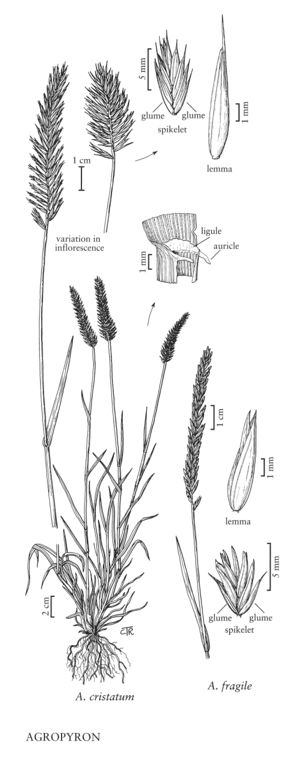| Taxon | Illustrator ⠉ | |
|---|---|---|
 | Agropyron cristatum Agropyron fragile | Cindy Roché Cindy Roché |
Plants perennial; densely to loosely cespitose, sometimes rhizomatous. Culms 25-110 cm, geniculate or erect. Sheaths open; auricles usually present; ligules membranous, often erose. Inflorescences spikes, usually pectinate; middle internodes 0.2-3 (5.5) mm, basal internodes often somewhat longer. Spikelets solitary, usually more than 3 times as long as the internodes, usually divergent or spreading from the rachis, with 3-16 florets; disarticulation above the glumes and beneath the florets. Glumes shorter than the adjacent lemmas, lanceovate to lanceolate, 1-5-veined, asymmetrically keeled, a secondary keel sometimes present on the wider side, keels glabrous or with hairs, hairs not tufted, apices acute and entire, sometimes awned, awns to 6 mm; lemmas 5-7-veined, asymmetrically keeled, acute to awned, awns to 4.5 mm; paleas from slightly shorter than to exceeding the lemmas, bifid; anthers 3, 3-5 mm, yellow. Caryopses usually falling with the lemmas and paleas attached, x = 7. Haplome P.
Distribution
Wash., Del., Wis., Idaho, Mont., Oreg., Wyo., Kans., N.Dak., Nebr., N.Mex., Okla., S.Dak., N.H., Ariz., Tex., Conn., N.Y., Calif., Nev., Colo., Alaska, Ill., Ind., Iowa, Utah, Mass., Ohio, Mo., Minn., Mich., Alta., B.C., Nfld. and Labr. (Nfld.), Man., N.S., N.W.T., Ont., Que., Sask., Yukon, Ky.
Discussion
Agropyron, it is now agreed, should be restricted to perennial species of Triticeae with keeled glumes, i.e., A. cristatum and its allies, or the "crested wheatgrasses". The excluded species are distributed among Pseudoroegneria, Thinopyrum, Elymus, Eremopyrum, and Pascopyrum. This leaves Agropyron as a Eurasian genus that includes diploid, tetraploid, and hexaploid plants, all of which contain a single genome, designated the P genome by the International Triticeae Consortium. The genus is now widespread in western North America, frequently being used for soil stabilization on degraded rangeland and abandoned cropland, because it is highly tolerant of grazing and provides good spring forage.
Prior to the 1930s, most Soviet agrostologists recognized two species in the genus: Agropyron cristatum, with broad spikes; and A. desertorum (Fischer ex Link) Schult., with narrow spikes. Kosarev (1949) recognized four species, the two additional species being A. pectiniforme Roem. & Schult. and A. sibiricwn (Willd.) P. Beauv. Tsvelev (1976) recognized 10 species, within one of which, A. cristatum, he recognized nine subspecies. He considered the widely distributed taxon introduced to many different countries to be A. cristatum subsp. pectinatum (M. Bieb.) Tzvelev. Chen and Zhu (2006) suggested that there are 15 species in the world, five of which are present in China.
Estimating the number of species present in the Flora region is difficult, because many seed samples were brought into the region, planted out in experimental plots, and subsequently developed for various agricultural uses. In reviewing the history of crested wheatgrass in North America, Dillman (1946) stated that, based on the identifications provided with some of the early seed accessions, two species of crested wheatgrass had been introduced into North America, Agropyron cristatum and A. desertorum. He described them as "quite distinct, both in seed and plant characters" (p. 248). According to Dewey (1986), a third species, now known as A. fragile, was introduced at about the same time; it apparently escaped Dillman's attention.
The problem is that "taxa introduced into North America soon lose their taxonomic identity and genetic integrity because of extensive intercrossing that occurs in nursery situations" (Dewey 1986, p. 34). Despite his observations, Dewey recognized three species of Agropyron in North America, and admitted that identifying individual plants "will often be difficult and unsatisfying. Variation is continuous between the morphological extremes of the unawned, linear-spiked A. fragile to the broad, pectinate-spiked A. cristatum'" (p. 38).
This treatment recognizes two species within the Flora region, a very broadly interpreted Agropyron cristatum, which includes Dewey's A. cristatum and A. desertorum, and a traditionally interpreted A. fragile. Agropyron cristatum in North America reflects a process that might be called despeciation.
Selected References
Lower Taxa
Key
| 1 | Lemmas usually awned, awns 1-6 mm long; spikelets diverging from the rachises at angles of 30-95°; spikes narrowly to broadly lanceolate, rectangular, or ovate in outline | Agropyron cristatum |
| 1 | Lemmas unawned, sometimes mucronate; spikelets diverging from the rachises at an angle of less than 30(35)°; spikes linear to narrowly lanceolate in outline | Agropyron fragile |
"decumbent" is not a number."+timesaslongastheinternodes" is not declared as a valid unit of measurement for this property.